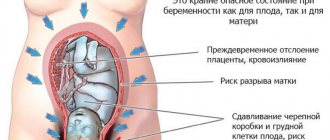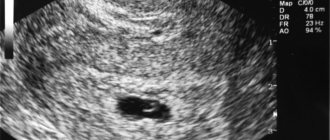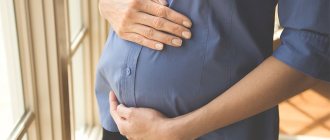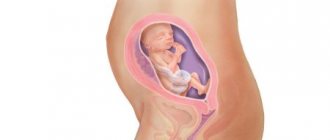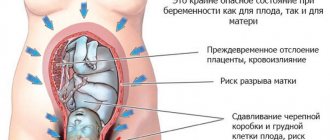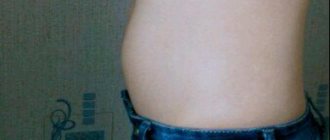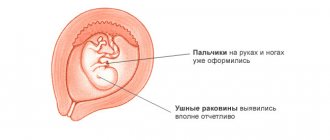Childbirth at 30 weeks of pregnancy
Childbirth that begins at 30 weeks of pregnancy is not timely. However, children born at this time survive in almost 100% of cases. Although, of course, it would be nice for the baby to stay in his mother’s belly for a few more weeks.
A child at 30 weeks already has a formed respiratory system; all its organs can function independently outside the mother’s body. His eyes open, his intestines are able to digest the first food, and his kidneys excrete urine.
Naturally, the child will not be able to survive without qualified assistance from doctors and without special equipment. However, if a woman goes to the hospital in a timely manner, childbirth at 30 weeks of pregnancy is completed successfully.
Pathological discharge
A pregnant woman should be alert if the discharge:
1) Red with blood.
2) Watery discharge most often indicates leakage of amniotic fluid, although the causes may be cracks in the walls of the uterus or their thinning.
3) Copious white mucous discharge.
If a pregnant woman observes any discharge that does not correspond to the norm, she should urgently call an ambulance or consult a doctor. 29-30 weeks of pregnancy is not a suitable period for the birth of a baby, but still a newborn can already be born and live outside the mother’s womb. Premature babies are most often born with weak immunity and are more susceptible to various types of infections and diseases.
Fetal development at 30 weeks of gestation
Every day the child gains weight and grows little by little. The length of his body is already approaching 40 cm, and the total weight is about 1500 kg. Moreover, now the baby’s body weight is made up, among other things, of subcutaneous fat, which is constantly accumulating.
The lungs begin to produce surfactant. It is needed to prevent the alveoli from sticking together during inhalation. However, the baby’s respiratory system is not yet perfect.
In the brain, the convolutions and grooves become more prominent, and nerve cells begin to function. The nerve fibers are gradually covered with a myelin sheath.
The baby's skin becomes smooth, wrinkles and lanugo (original fluff) disappear. Although often children born on time remain covered with vellus hairs, which gradually disappear. There's nothing wrong with that. Protective lubricant still covers the fetal body.
At this time, the liver continues to work actively, it accumulates iron, which will provide the child’s blood with red blood cells.
A baby's heart beats very fast compared to an adult's heart rate. Moreover, girls have more beats per minute than boys.
The baby becomes increasingly cramped in the mother's belly, since the uterus cannot stretch indefinitely. Most often, at week 30, the fetus is already in the position in which it will be born. Normally, the child is positioned with his buttocks up and his head pressed against the woman’s pelvic bones.
Since there is little room left in the uterus for active movements, the baby behaves more calmly than before. All women note this. In the case when he continues to make sharp and strong thrusts, the expectant mother should show concern and inform the doctor about this.
Surprisingly, the baby can already smile, yawn, frown, and blink. His eyes are open, so he sees bright light and reacts to it.
What tests should be taken at 30 weeks of pregnancy?
The woman currently visits the doctor once every two weeks, but soon she will have to increase her visits to the doctor more often. If a visit to a gynecologist was planned at week 30, he will give directions for standard tests: a general blood and urine test.
Also, during a visit to the doctor, you need to prepare for the fact that a smear will be taken for flora, blood for HIV and Rh factor. Naturally, the doctor will monitor the woman’s blood pressure, measure the circumference of her abdomen and the height of the uterine fundus. Using a special tube, the doctor will listen to the fetal heartbeat and manually try to determine its position.
Is it necessary to undergo an ultrasound?
Provided that the pregnancy is progressing normally, ultrasound is not prescribed at this stage. It is most often planned for the 32nd week of pregnancy. Although it is possible that the doctor can give a referral now.
The purpose of an ultrasound examination is to monitor the child’s condition. The specialist evaluates the development of the fetus, the quality and volume of amniotic fluid, the degree of maturity of the placenta, and clarifies exactly how the baby is located in the uterus. At the same time, fetal pathologies such as heart defects, intestinal and urinary tract obstruction can be detected.
To assess uteroplacental and fetoplacental blood flow, a woman may be referred for Doppler ultrasound.
How does the mother’s well-being change?
It becomes more and more difficult for a woman:
- she cannot do household chores;
- it is difficult for her to find a comfortable position for sleeping;
- she often wakes up when the baby starts kicking;
- Every night she gets up several times to go to the toilet.
Many mothers cannot withstand the increasing load, and their mental state changes. They become irritable, nervous and withdrawn. If you cannot cope with your mood on your own, it is recommended to consult a specialist. Since after childbirth the situation often worsens and real depression can develop.
During this period, it is important to visit a gynecologist weekly, who will measure basic parameters (weight, abdominal circumference, distance from the pubic joint to the fundus of the uterus). It is advisable to perform another smear test from the vagina and cervix, and if an infection is detected, it is necessary to undergo treatment. This is necessary to prevent infection of the child during passage through the birth canal.
Starting from the thirtieth week, each pregnant woman should have two bags for the maternity hospital.
She will take the first one with her when labor begins, and the second one will be brought by the child’s father after his birth. The list of permitted items may vary in different maternity hospitals, so it is better to check with the doctor who will deliver the child.
- The baby continues to grow, it becomes crowded in the uterine cavity.
- The child's movements are limited, but he sees and hears well.
- Mom may experience a decrease in mood due to chronic fatigue, so it is very important to help and support her in everything.
- You need to collect two packages of necessary things for the maternity hospital.
What's happening to the stomach?
It is quite logical that the belly becomes quite large at this stage of pregnancy. It shows on his skin. It is now very tight, which increases the risk of stretch marks. To reduce it to a minimum, you need to use special moisturizing creams or oils of plant origin (almond, olive, coconut oil). The abdominal muscles are also very stretched and weakened.
The center of gravity shifted to the stomach makes the woman clumsy, so she needs to be especially careful. For example, you shouldn’t get out of bed abruptly; it’s better to first roll over to your side and then raise your torso.
What to pay attention to
- Since the belly at 30 weeks of pregnancy increases significantly in size, it becomes more difficult for a woman to move around and perform simple household chores. In order to avoid any undesirable consequences, it is important to make slow movements - carefully get out of bed, avoid sharp turns and bends.
- Due to softening of the ligaments and joints, as well as a large belly, a woman may experience lower back pain. To get rid of this unpleasant symptom, a pregnant woman should maintain correct posture. For this purpose, as well as to maintain the abdominal muscles, the doctor may recommend wearing a special bandage.
- The abdomen, increasing in volume, causes stretching of the skin and itching. One of the serious cosmetic consequences of a large belly is stretch marks, which are easier to prevent than to eliminate later. To combat them, oils - citrus, almond, olive, as well as specialized creams are very effective. If itching is severe, you should never scratch the skin; this will only increase the number of stretch marks. To relieve itching, it is recommended to massage the skin using the above oils and special lotions.
- When a woman is bothered by leg cramps, walking barefoot on the floor will help relieve the condition. You can also use kneading exercises or exercises in which the woman pulls the toe of her foot towards herself.
- Sex at 30 weeks of pregnancy is not prohibited if there are no medical contraindications, which include multiple pregnancies, the threat of premature birth and other pathologies that threaten the bearing of a child. In this case, you should choose comfortable poses, avoid rough and active movements, as well as pressure on the abdomen.
After going on maternity leave, it is important for a woman to rest more, walk in the fresh air and perform low-intensity physical exercise. This will not only improve the shape, but also avoid fetal hypoxia.
What happens to the uterus?
By this time, the uterus rises above the navel by more than 10 cm. The distance to the pubis increases to 30 cm.
At this time, the uterus begins to prepare for the upcoming birth through rhythmic contractions. They may cause minor pain and a feeling of abdominal tension. These first contractions are called training or Braxton-Higgs contractions. Such contractions of the uterus do not lead to childbirth and do not pose any threat.
It is important to be able to distinguish training contractions from real ones. So, real contractions will be accompanied by severe painful sensations, possible discharge with blood, discharge of amniotic fluid and other signs of impending labor. In this case, you cannot hesitate to call an ambulance.
As for training contractions, they go away very quickly on their own, do not tend to intensify and do not cause severe pain. In order to eliminate them, just walk around the room or change your body position.
Feel
A woman’s feelings at 30 weeks of pregnancy can be very varied. For example, the expectant mother begins to experience heartburn and belching. Possible development of constipation, increased urination, and lack of air. All this is due to the fact that the enlarged uterus puts pressure not only on the diaphragm, but also on the intestines and bladder.
At the same time, the woman experiences joy from the fact that very soon she will become a mother, and now a new life is maturing inside her. At the same time, the baby does not let you forget about himself, as he constantly moves. However, the nature of his movements changes. If earlier he swam freely inside the uterus, now he can only turn and push. Therefore, the woman clearly feels the movements of the child’s elbows, heels and knees.
It is important to monitor the baby’s movements, as they are one of the main signs of his well-being. The fetus may become more active when the abdomen is exposed to bright light or loud sounds. Increased movements may be a signal that the baby is not getting enough oxygen. A long “calm” in the stomach can also be considered a negative sign.
That’s why it’s so important to track the number of movements the baby makes. Normally, there should be about 6 of them per hour, and at least 24 per day.
Causes of pain occurring at 30 weeks of pregnancy
Painful sensations at 30 weeks can indicate both normal pregnancy and pathology. Therefore, it is necessary to listen to your body and understand what it is signaling.
- Lumbar and back pain are the result of increased stress on them. In addition, the center of gravity shifts, and the ligaments gradually soften. Therefore, it is not surprising that some discomfort occurs in the back area. To reduce its severity, you need to monitor your posture, perform feasible physical exercises, and provide high-quality relief to the spine.
- Pain in the intestinal area can be caused by indigestion, for example, due to errors in nutrition. Therefore, it is so important to avoid eating foods that can cause increased gas formation. For this purpose, it is recommended to limit grapes, confectionery products, legumes, and cabbage.
- Mild abdominal pain can be caused by training contractions.
- A woman may have a headache. This is due to changes occurring in her body. To reduce unpleasant symptoms, you should not immediately resort to taking medications. First you just need to lie down and rest. If the headache does not go away, then you need to consult a doctor and find out which drug can be used to eliminate it. To prevent headaches, it is recommended to get more rest, go to bed in a pre-ventilated room, and walk in the fresh air.
In addition to pain, at 30 weeks of pregnancy a woman may begin to experience swelling. If they are weak, then you can try to limit your salt and liquid intake. It is recommended to drink no more than 1.5 liters of water per day. It is important to exclude from the diet foods that can provoke thirst - these are spicy, fried, pickled, fatty foods, as well as sweet carbonated water.
To reduce the severity of swelling, you need to rest more often with your legs elevated. It is important not to spend a long time in a static position (do not stand or sit for a long time).
If swelling does not go away within 24 hours, or even worsens, then you need to visit a doctor. It is possible that they are the first sign of gestosis. This condition poses a threat to the health of both women and children.
The main causes of nagging pain in the lower abdomen at 30 weeks
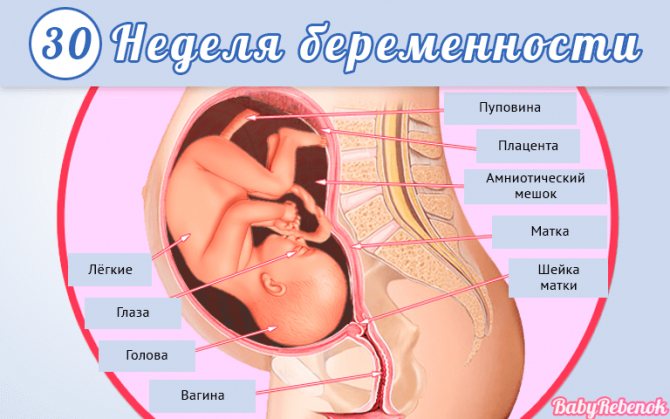
There is very little time left before the birth, so you can already start preparing for the birth of your baby. The woman gains weight by the indicated date, becomes overweight and clumsy. She has difficulty with some movements. Without outside help, it becomes impossible to carry out your usual household chores.
The baby already weighs appreciably 1600 grams, his height is 40 cm. The skin of the fetus is smoothed out. This occurs due to the formation of a fat layer. The brain grows and develops, new convolutions constantly appear. The “tuning” of the nervous system continues. The lungs will soon be able to breathe on their own. In the meantime, in the womb, the child tries to take his first breaths. The eyes are open.
Most of the time, the unborn baby sleeps, but when he is awake, he behaves actively: he sucks his finger, touches his body with his hands, pushes with his legs if he doesn’t like something. Mom feels these tremors well. They cause her minor pain in the lower abdomen, but it is short-lived - it occurs suddenly and immediately goes away when the child calms down.
The uterus rises above the navel at a level of 10 cm. The ligaments that hold it experience high stress. Their stretching also causes noticeable discomfort: it pulls in the lower abdomen, as during menstruation. The pain is constantly present, but goes away when the woman lies down and rests, covering herself with pillows.
The appearance of aching pain spreading in a circle and radiating to the lower back may be associated with a shift in the center of gravity. Every day the woman becomes bigger. In order to hold her stomach and not fall, she is forced to change her gait and transfer the load to her back. Any hasty or sudden movement can lead to a fall. This must not be allowed under any circumstances. It is important to be extremely careful, do not go out alone, carefully get into and out of the bathroom, and try not to take public transport.
Sometimes the discomfort gets worse. This happens because the uterus begins to prepare for the birth of the baby. Training contractions are formed periodically. They are very short-lived, lasting seconds. New attacks do not appear immediately, but after a long time. This preparatory state differs from the beginning of labor.
The internal organs become cramped and feel pressure. The liver, pancreas, gall and bladder, intestinal loops, stomach and even the heart, under the pressure of the uterus, are slightly deflected and partially pressed down by the reproductive organ. Because of this, dysfunctions are formed that can lead to dangerous complications. If you listen carefully to your body, it is not difficult to understand where exactly the pathology is localized.
Nutritional features at 30 weeks
A woman must structure her menu in such a way that it covers the needs of her body and the body of the child growing inside. The daily diet must be enriched with vitamins, minerals, protein, fiber and complex carbohydrates.
It is worth giving preference to products such as cottage cheese, vegetables, fruits, cereals, berries, fermented milk drinks, seafood, fish, lean meat. All products based on white flour, sweets, and baked goods are subject to strict restrictions. Also, don’t get too carried away with cabbage, grapes, legumes, or freshly baked bread.
You should not risk your health and eat foods that have not undergone proper heat treatment. Be sure to boil both milk and water. Fresh fruits and vegetables must be thoroughly washed, meat and fish must be well boiled.
Do not get carried away with foods that can provoke an allergic reaction. For example, this includes nuts, honey, caviar, eggs, chocolate, etc.
What kind of discharge can there be at 30 weeks?
If a woman’s discharge has a milky tint, a uniform consistency and a slightly sour smell, but has become slightly more abundant, then this is normal. They should be free of mucus, foam, clots, pus and other foreign matter. If they appear, you should consult a doctor. Most often, a change in the nature of the discharge indicates the addition of an infection, which requires immediate treatment.
When blood appears in the discharge, there should be no delay in calling an ambulance. It doesn’t matter whether the woman is bleeding heavily or not. Bloody discharge indicates various pregnancy pathologies, ranging from premature birth to placental abruption.
Massive loss of water or leakage also requires calling an ambulance and hospitalization. If the amniotic fluid comes out in small portions, then this indicates depletion of the placenta, and if the water is abundant, then the onset of premature birth.
Important Tips
- A woman’s menu should not contain foods that can cause bloating or indigestion.
- When resting at night, you should not roll over onto your back. At this stage, a woman should sleep only on her side.
- All movements of a woman should be measured, which will avoid injury.
- Massage will improve blood flow, reduce swelling and relieve tension in the legs. It’s good if your back is massaged at the same time.
- At 30 weeks of pregnancy, you should always have a medical card and other documents at hand for traveling to the maternity hospital.
Normal discharge
Discharge at the 30th week of pregnancy, as in earlier stages, should be present, but its quantity and color must be systematically monitored. Normally they should be:
– in small quantities;
– transparent color;
– without foreign odors.
Any discharge that differs from this norm should alert the pregnant woman and serve as a signal for urgent medical attention. Discharge of a different consistency, smell, or quantity is considered pathological, as it threatens premature birth and termination of pregnancy.
Discharge at the 30th week of pregnancy is a very important indicator, so a woman needs to know its norm in order to promptly attract qualified medical help and eliminate violations.
Answers to popular questions
- I am 30 weeks pregnant, can I have a 3D ultrasound at this time?
This study is absolutely safe for the child, so at this time it is quite possible to perform it and take a photo as a souvenir.
- Is increased discharge at 30 weeks of pregnancy normal?
Discharge may become more abundant compared to previous periods of pregnancy, which is normal. However, if their smell, color or consistency changes, this will indicate an infection. In this case, you need to contact a gynecologist.
- Is it possible to have sex at 30 weeks pregnant?
If there are no medical contraindications for intimate life, then having sex during this period is allowed. However, it is important to avoid any pressure on the abdomen and too intense movements.
- Can the position of the fetus change at 30 weeks of pregnancy if I am diagnosed with breech presentation?
To change the position of the baby in the uterus for such a long period of time, it is necessary to perform special exercises. Therefore, it is important to consult a doctor about this.
Author of the article: Lapikova Valentina Vladimirovna | Gynecologist, reproductive specialist
Education: Diploma in Obstetrics and Gynecology received from the Russian State Medical University of the Federal Agency for Health and Social Development (2010). In 2013, she completed her postgraduate studies at NIMU named after. N.I. Pirogova.
Our authors
External development of the fetus
The fetus at 30 weeks of gestation weighs about 1400–1700 grams, and its growth reaches 40–43 centimeters. The baby's skin still remains reddish, but is no longer as wrinkled as before, because the subcutaneous layer of fat is becoming larger and the pupillary film disappears. In boys, the testicles descend into the scrotum, and in girls, the process of formation of the vagina and external genitalia ends. The fetus at the 30th week of pregnancy in most cases is still head up, although it also happens that it drops and takes a head down position.
All organs and systems of your baby’s body should be formed by this time, and the baby, born at this stage, will, in principle, be able to eat, grow and fully develop, although, of course, premature babies require close monitoring and special care if born at this stage like 30 weeks. What happens in the last 10 weeks of baby's development? They will be aimed at weight gain and growth. Just imagine that his body weight will more than double and his height will increase by 10-15 centimeters.
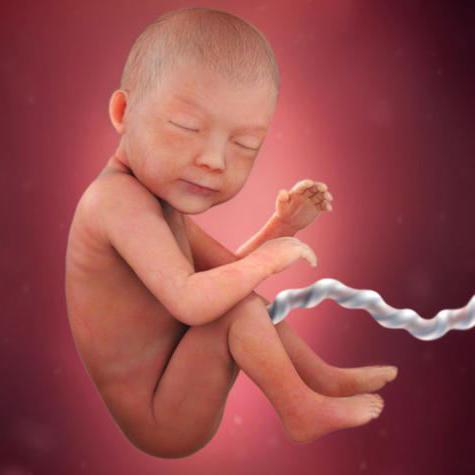
The first hairs in the form of a fluff called lanugo begin to slowly disappear from the baby’s head and from his entire body. Before birth, lanugo most often disappears completely, but there are often cases when babies are born with hair on their heads and such vellus cover all over their bodies. But as a rule, such fluff disappears in the first months of your baby’s life.
